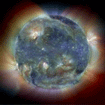Journey of a river
The work of the river;
The work of the river;
Moving water has energy. The faster it moves the more energy it has.
Rivers have energy, and they can wear things down, move things and carry them along as they flow. We call this the work of the river. The faster a river flows, the more energy it has and the more work it can do. Streams and rivers alter the* landscape by redistributing material through the three processes of erosion, transportation and deposition.
Rivers have energy, and they can wear things down, move things and carry them along as they flow. We call this the work of the river. The faster a river flows, the more energy it has and the more work it can do. Streams and rivers alter the* landscape by redistributing material through the three processes of erosion, transportation and deposition.
The start of a river
The start of a river is its source, which could be melting snow or ice, a spring (water bubbling out of the ground), a lake or a bog. The source of a river is usually in upland areas such as mountains or hills. Small streams flow downhill from the source and join other streams until they form the main river of a river system. The streams are the tributaries of the main river. In upland areas, water in streams and rivers is very fast-flowing, cutting and eroding the land to form valleys, and features such as waterfalls.
A confluence;
Where two streams join, or a stream joins a river, this is called a confluence. When the ground becomes flatter, the river slows down and starts to swing from side to side (meandering), making large bends (meanders). Sometimes, these large bends become cut off from the main river, and ox bow lakes are
formed.
The mouth;
The end of a river, where it flows into the sea or sometimes a lake, is called its mouth. The area where the river meets the sea (the tidal part of the river) is called the estuary. A delta may be formed near the mouth of the river, if the land is very flat and the river is very slow-flowing and carrying a lot of sediment.
formed.
The mouth;
The end of a river, where it flows into the sea or sometimes a lake, is called its mouth. The area where the river meets the sea (the tidal part of the river) is called the estuary. A delta may be formed near the mouth of the river, if the land is very flat and the river is very slow-flowing and carrying a lot of sediment.
Journey of a river
1. What does all moving water have in it?
2. Complete:
The faster the river flows, the more_______________ .
3. What do we call the beginning of the river?
4. Where does the source come from?
5. Where would we usually find the source of a river? Why?
6. How do streams and rivers change the landscape?
7. How do small streams become part of the river?
8. What do we call these small streams that become part of a river?
9. Where do rivers flow very fast?
10. What happens when fast-flowing water passes?
11. What is a confluence?
12. Why do rivers start flowing slowly?
13. What is a meander?
14. At the end of a river, what do we call the place where the river meets the sea?
15. How are deltas form
1. What does all moving water have in it?
2. Complete:
The faster the river flows, the more_______________ .
3. What do we call the beginning of the river?
4. Where does the source come from?
5. Where would we usually find the source of a river? Why?
6. How do streams and rivers change the landscape?
7. How do small streams become part of the river?
8. What do we call these small streams that become part of a river?
9. Where do rivers flow very fast?
10. What happens when fast-flowing water passes?
11. What is a confluence?
12. Why do rivers start flowing slowly?
13. What is a meander?
14. At the end of a river, what do we call the place where the river meets the sea?
15. How are deltas form










No comments:
Post a Comment